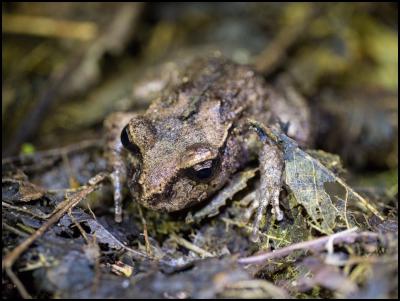Maud Island Frogs hop across Wellington
MEDIA RELEASE – For Immediate
Release
18 April
2016

Maud Island Frogs hop across Wellington
Wellington, NZ – Maud Island Frogs hop across Wellington Five nationally endangered Maud Island Frogs have made a giant leap – moving from Zealandia to Wellington Zoo this week.
The move will see the nocturnal frogs take residence at Meet the Locals He Tuku Aroha, a New Zealand experience which celebrates Wellington Zoo’s love story to Aotearoa.
“In Meet the Locals He Tuku Aroha, we shine a light on some of New Zealand’s lesser known locals,” says Oli du Bern, Visitor Experience Manager. “We want to engage people in the story of Maud Island Frogs and how we can all protect their future.”
Zoo staff will be using their skills in animal care and research to care for the reclusive frogs – and use any learnings to increase knowledge about how to care for New Zealand’s other endangered frog species.
"It's fantastic to have populations healthy enough a point where we can transfer them out of the sanctuary," said Zealandia Conservation Manager Raewyn Empson.
In February 2006 a transfer of Maud Island frogs to Zealandia saw their return to a natural environment on mainland New Zealand for the first time in hundreds of years. In February 2008 froglets hatched in Zealandia becoming the first froglets to hatch on the mainland in the wild and a significant milestone.
“Zealandia and Wellington Zoo are both iconic Wellington conservation organisations, and we are united in our passion for saving animals in the wild,” says Daniela Biaggio, Conservation Manager Wellington Zoo. “Our four New Zealand native frog species are all threatened, so it’s important that we combine our efforts and expertise to help conserve these unique treasures.”
New Zealand’s native frogs are the most ancient and primitive frogs in the worlds, with several distinct features. Unlike other frogs, they have round eyes, no external ear drum, and they don’t croak. Moreover, our native frog species don’t have a tadpole stage – instead, the embryo develops inside an egg before hatching as an almost-formed frog. Parents care for their young, with froglets clinging to adult male Maud Island Frogs.
Zoo staff have been involved with Maud Island Frog research, with Animal Welfare Advisor Dr. Bridget Brox journeying to Maud Island to assist with frog surveys. The week-long survey saw Dr. Brox join a research team led by Dr. Ben Bell from Victoria University to monitor and track frogs during the night.
More Zoo staff joined the Zealandia team to undertake a census of one of the habitats in the sanctuary. The census from the habitats at Zealandia shows a growing breeding population.
More information
The Maud Island Frog is one of New Zealand’s four surviving native frog species, all of which are nationally endangered. Like other native frogs they do not produce vocalisations to attract mates, instead communicating through chemical signals. There are approximately 20,000 Maud Island frogs left in New Zealand living on a few offshore islands and protected areas like Zealandia.
ENDS


 School Lunch Collective: Compass Group New Zealand To Acquire Libelle Group Securing Healthy School Lunch Programme
School Lunch Collective: Compass Group New Zealand To Acquire Libelle Group Securing Healthy School Lunch Programme PSA: PPPs Pose Risks To New Zealand Workers
PSA: PPPs Pose Risks To New Zealand Workers Office of the Privacy Commissioner: New Research Shows Business Leaders Fear Being On The Hook For Others’ Privacy Breaches
Office of the Privacy Commissioner: New Research Shows Business Leaders Fear Being On The Hook For Others’ Privacy Breaches E Tū: E Tū Members Send Open Letter To James Grenon And NZME Board
E Tū: E Tū Members Send Open Letter To James Grenon And NZME Board Commerce Commission: Commission Calls For Comments On Copper Access Deregulation
Commerce Commission: Commission Calls For Comments On Copper Access Deregulation New Zealand Association of Scientists: NZAS Supports Saving Biotechnology Capacity In Callaghan; Asks What Now For Applied Technology Group
New Zealand Association of Scientists: NZAS Supports Saving Biotechnology Capacity In Callaghan; Asks What Now For Applied Technology Group



